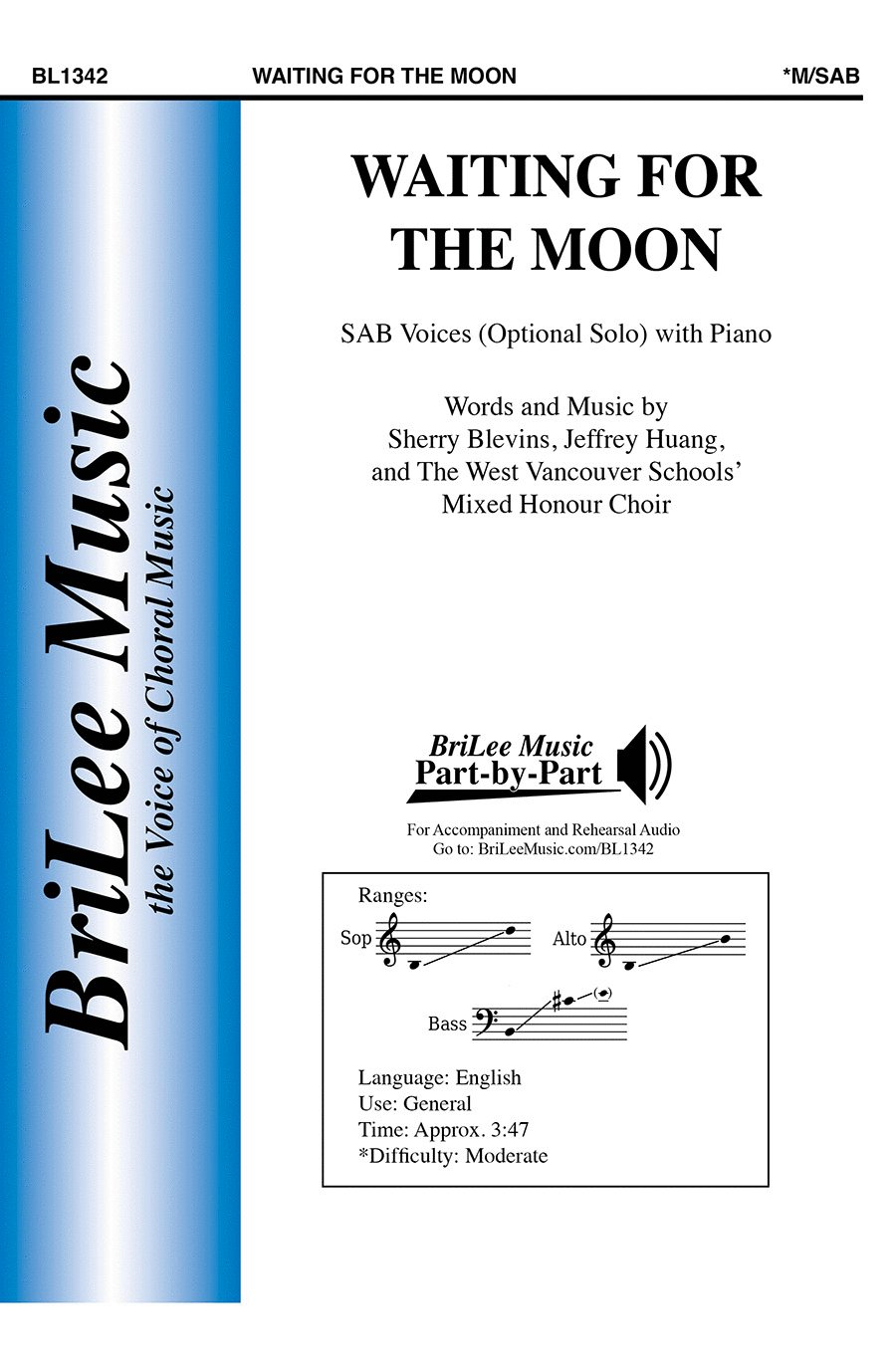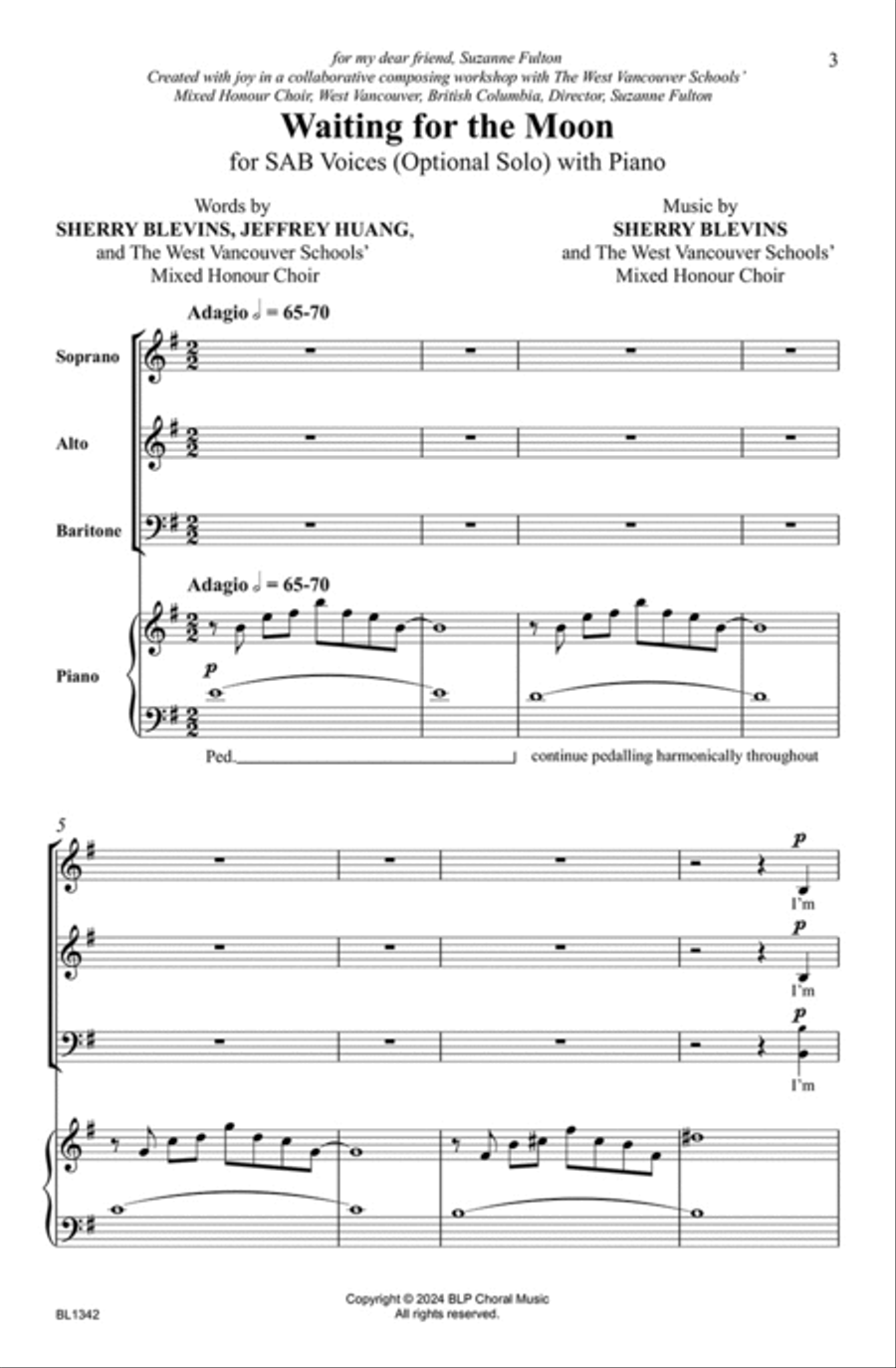Choral Piano, alto voice, bass voice, solo Voices, soprano voice
SKU: CF.BL1342
Composed by Sherry Blevins. Octavo. Octavo. 12 pages. Duration 3 minutes, 47 seconds. BriLee Music #BL1342. Published by BriLee Music (CF.BL1342).
UPC: 672405011556. 6.875 x 10.5 inches. Key: E major,e minor. English. Sherry Blevins. Original and JEFFREY HUANG, and The West Vancouver Schools' Mixed Honour Choir.
I am delighted that you’ve selected Waiting for the Moon for your singers! Here are some practical, accessible tips to ensure a great performance: This piece is most effective when singers apply great dynamic contrast. For the most success, incorporate varying dynamics in your warmup exercises and train singers to your gesture so that they will respond appropriately with dynamic expression throughout the piece. When singing the word “fire”, sing the first syllable, [faI-] on the first pitch and the second syllable [ə(r)] on the second pitch. This piece provides an opportunity to teach students about the contrasts between the A and B sections of the piece: from minor to major; from a polyphonic texture (partner songs) to unison/solo and homophony; and finally, from somber to hopeful. Composer NotesMy latest passion is teaching collaborative workshops where singers work with me to compose new works that they will later perform and that hopefully, will be published for others to enjoy.In 2020, Suzanne Fulton of the West Vancouver Schools’ Honour Choirs, invited me to work with her students via Zoom. Together, we decided that having her singers compose would be a great way for them to not only express their feelings about current events, but also to learn more about the song-writing process. From almost 3,000 miles away, I taught four of her choirs to do just that and Waiting for the Moon was born.Waiting for the Moon was co-composed with Suzanne’s Mixed Honour Choir. During our session, I asked students to write poetry ; lyrics that would become our song. Typically, when teaching composing workshops, I use the poetry of many singers, but in this case, one young man named Jeffrey Huang wrote something so poignant and beautiful that the entire choir decided that it was all they needed to say. Here are his words:I’m standing in the still fire,Waiting for the moon to come.We then took turns describing what those words meant to us. At the time, these singers were struggling with the isolation of a lockdown during the Coronavirus Pandemic. While Jeffrey’s words could describe any struggle, for them, it was clearly about their sadness and isolation. They decided we would add narration to explain:Imagine being immobilized before an unrelenting sun. You are still, but not at peace.You are fearful of what may come while feeling powerless and despondent in its oppressive rays.[Begin piano introduction] *The lyrics of this song were written in 2020 as a reflection of the experiences shared during the coronavirus pandemic. All of us now know the intense feeling of being isolated, scared, and frozen in space and time just waiting for relief, waiting for better days, just waiting for the moon to come.It is up to the director whether narration should be included or not. It may be most meaningful to ask the singers what the text means to them and then have them create their own narration. If you choose to add narration of a similar length, you may repeat the piano introduction as needed. You may also allow the narrator to begin speaking first and then have the piano come in later. Experiment with what works for you and your singers.Whether or not narration is used, let the audience interpret the lyrics for themselves. Either way, it is my hope that you enjoy this cathartic piece about overcoming the challenges that life can sometimes bring.
I am delighted that you’ve selected Waiting for the Moon for your singers! Here are some practical, accessible tips to ensure a great performance:This piece is most effective when singers apply great dynamic contrast. For the most success, incorporate varying dynamics in your warmup exercises and train singers to your gesture so that they will respond appropriately with dynamic expression throughout the piece.When singing the word “fire”, sing the first syllable, [faI-] on the first pitch and the second syllable [ə(r)] on the second pitch.This piece provides an opportunity to teach students about the contrasts between the A and B sections of the piece: from minor to major; from a polyphonic texture (partner songs) to unison/solo and homophony; and finally, from somber to hopeful.xa0Composer NotesMy latest passion is teaching collaborative workshops where singers work with me to compose new works that they will later perform and that hopefully, will be published for others to enjoy.In 2020, Suzanne Fulton of the West Vancouver Schools’ Honour Choirs, invited me to work with her students via Zoom. Together, we decided that having her singers compose would be a great way for them to not only express their feelings about current events, but also to learn more about the song-writing process. From almost 3,000 miles away, I taught four of her choirs to do just that and Waiting for the Moonxa0was born.Waiting for the Moon was co-composed with Suzanne’s Mixed Honour Choir. During our session, I asked students to write poetry ; lyrics that would become our song. Typically, when teaching composing workshops, I use the poetry of many singers, but in this case, one young man named Jeffrey Huang wrote something so poignant and beautiful that the entire choir decided that it was all they needed to say. Here are his words:I’m standing in the still fire,Waiting for the moon to come.We then took turns describing what those words meant to us. At the time, these singers were struggling with the isolation of a lockdown during the Coronavirus Pandemic. While Jeffrey’s words could describe any struggle, for them, it was clearly about their sadness and isolation. They decided we would add narration to explain:Imagine being immobilized before an unrelenting sun. You are still, but not at peace.You are fearful of what may come while feeling powerless and despondent in its oppressive rays.[Begin piano introduction] *The lyrics of this song were written in 2020 as a reflection of the experiences shared during the coronavirus pandemic. All of us now know the intense feeling of being isolated, scared, and frozen in space and time just waiting for relief, waiting for better days, just waiting for the moon to come.It is up to the director whether narration should be included or not. It may be most meaningful to ask the singers what the text means to them and then have them create their own narration. If you choose to add narration of a similar length, you may repeat the piano introduction as needed. You may also allow the narrator to begin speaking first and then have the piano come in later. Experiment with what works for you and your singers.Whether or not narration is used, let the audience interpret the lyrics for themselves. Either way, it is my hope that you enjoy this cathartic piece about overcoming the challenges that life can sometimes bring.
I am delighted that you’ve selected Waiting for the Moon for your singers! Here are some practical, accessible tips to ensure a great performance:This piece is most effective when singers apply great dynamic contrast. For the most success, incorporate varying dynamics in your warmup exercises and train singers to your gesture so that they will respond appropriately with dynamic expression throughout the piece.When singing the word “fire”, sing the first syllable, [faI-] on the first pitch and the second syllable [?(r)] on the second pitch.This piece provides an opportunity to teach students about the contrasts between the A and B sections of the piece: from minor to major; from a polyphonic texture (partner songs) to unison/solo and homophony; and finally, from somber to hopeful.xa0Composer NotesMy latest passion is teaching collaborative workshops where singers work with me to compose new works that they will later perform and that hopefully, will be published for others to enjoy.In 2020, Suzanne Fulton of the West Vancouver Schools’ Honour Choirs, invited me to work with her students via Zoom. Together, we decided that having her singers compose would be a great way for them to not only express their feelings about current events, but also to learn more about the song-writing process. From almost 3,000 miles away, I taught four of her choirs to do just that and Waiting for the Moonxa0was born.Waiting for the Moon was co-composed with Suzanne’s Mixed Honour Choir. During our session, I asked students to write poetry ; lyrics that would become our song. Typically, when teaching composing workshops, I use the poetry of many singers, but in this case, one young man named Jeffrey Huang wrote something so poignant and beautiful that the entire choir decided that it was all they needed to say. Here are his words:I’m standing in the still fire,Waiting for the moon to come.We then took turns describing what those words meant to us. At the time, these singers were struggling with the isolation of a lockdown during the Coronavirus Pandemic. While Jeffrey’s words could describe any struggle, for them, it was clearly about their sadness and isolation. They decided we would add narration to explain:Imagine being immobilized before an unrelenting sun. You are still, but not at peace.You are fearful of what may come while feeling powerless and despondent in its oppressive rays.[Begin piano introduction] *The lyrics of this song were written in 2020 as a reflection of the experiences shared during the coronavirus pandemic. All of us now know the intense feeling of being isolated, scared, and frozen in space and time just waiting for relief, waiting for better days, just waiting for the moon to come.It is up to the director whether narration should be included or not. It may be most meaningful to ask the singers what the text means to them and then have them create their own narration. If you choose to add narration of a similar length, you may repeat the piano introduction as needed. You may also allow the narrator to begin speaking first and then have the piano come in later. Experiment with what works for you and your singers.Whether or not narration is used, let the audience interpret the lyrics for themselves. Either way, it is my hope that you enjoy this cathartic piece about overcoming the challenges that life can sometimes bring.





